|
 DYNAFLOW, INC. is working extensively on the modeling of the interaction
between cavitation and explosion bubbles and nearby structures and/or free-surfaces
and has created 2DYNAFS© (axisymmetric version) and 3DYNAFS© (3D version) Free
Surface Hydrodynamic Modeling code using the highly efficient Boundary Element
Method (BEM). These codes are very efficient in studying fluid flow in the
presence of large free surface deformations. DYNAFLOW, INC. is working extensively on the modeling of the interaction
between cavitation and explosion bubbles and nearby structures and/or free-surfaces
and has created 2DYNAFS© (axisymmetric version) and 3DYNAFS© (3D version) Free
Surface Hydrodynamic Modeling code using the highly efficient Boundary Element
Method (BEM). These codes are very efficient in studying fluid flow in the
presence of large free surface deformations.
User specified inputs for 2DYNAFS© or 3DYNAFS© include:
- Initial boundaries geometry
- Fluid constants
- Ambient pressure or driving pressure variations with time
- Gas Equation of State for bubbles and their internal initial pressure
- Gravitational Constant
The model, based on the BEM, utilizes Green's identity to reduce the number
of dimensions of the problem by one. A potential field problem is reduced to a
solution of the potential and its normal derivative along the boundary of the
domain. Thus a three-dimensional problem is transformed into a two-dimensional
boundary calculation while a two-dimensional problem becomes a one-dimensional
calculation. This results in drastic reduction in computational time compared
with other types of hydrodynamic codes, making it feasible to run versions of
the code on workstations and high end PCs.
Typical Applications Include:
- Explosions Near Bodies and Ocean Surface
- Waves Generated by a Body Motion
- Breaking Waves on a Sloped Beach
- Bubble Deformation in Non Uniform Flow Fields
- Multi Bubble Interaction
- Interaction Between Free Surfaces and Vortical Flow Field
- Fluid Structure Interactions
- Cavitation Inception and Noise
|









